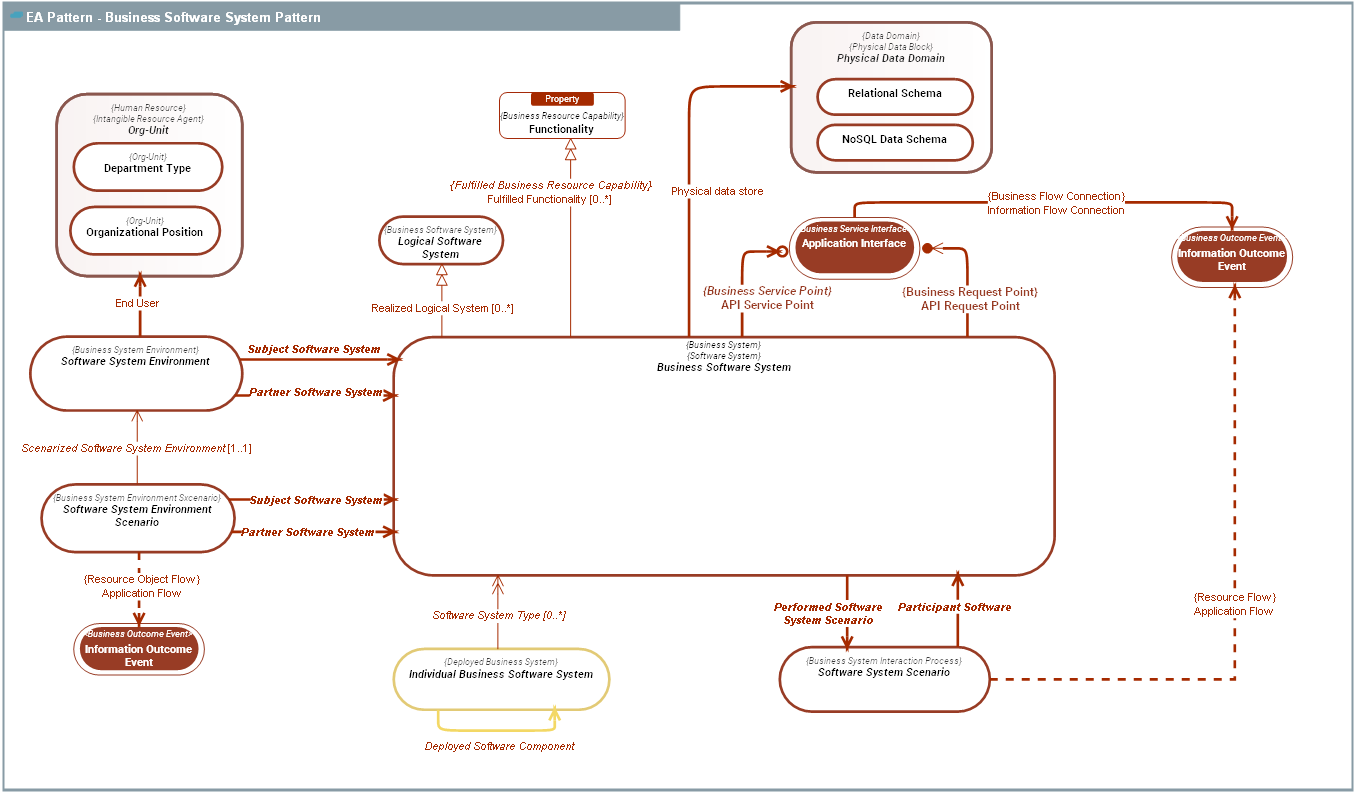CONCEPT DOMAIN - EA Pattern - Business Software System Pattern
| Description | Pattern Domain The EA Pattern - Business Software System Pattern domain provides concepts and abstractions shared by all Business Software Systems. |
|---|---|
| External references |
 OpenGroup - ArchiMate - Layer - Application Layer OpenGroup - ArchiMate - Layer - Application Layer |
| Dictionary |  Dictionary of SysFEAT concepts
Dictionary of SysFEAT concepts |
| Parent Domain |  SysFeat Business Operation Model Patterns
SysFeat Business Operation Model Patterns |
| Domain dependencies |  EA Pattern - Business Resource Operating Pattern
EA Pattern - Business Resource Operating Pattern  EA Pattern - Business System Operating Model
EA Pattern - Business System Operating Model  EA Pattern - Physical Data Domain
EA Pattern - Physical Data Domain  Logical Application Architecture
Logical Application Architecture  People & Accountability
People & Accountability  Resource System Operating Framework (R-SOF)
Resource System Operating Framework (R-SOF) |
DOMAIN CONCEPT GRAPH
Diagram Graph

CONCEPT DESCRIPTIONS
Concrete Concepts
| Concept | Description |
|---|---|
 Application Interface
Application Interface |
An Application Interface is a Business Service Interface that occurs between Business Software Systems. The interface is described by messages exchanged between endpoints (provider, consumer..). |
 Department Type
Department Type |
A Department Type is a Mezzo Org-Unit which serves as an administrative unit template in both government and business Organizations. Examples: - Sales department; - Finance department; - Logistics department..
|
 Functionality
Functionality |
A Functionality is a Business Resource Capability offered by Business System Assets (software or hardware) and aimed at delivering Information Outcomes. A Functionality describes WHAT a software or hardware system can provide. Functionality(ies) are used to express the Business System features required by people when performing their job (see Job-to-be-done). For internal customers, these jobs correspond to Business-Process Steps described in Business Process (see Instrument) For enterprise Customers, these jobs correspond to Job-to-be-done in the context of Customer Journeys. |
 Information Outcome Event
Information Outcome Event |
An Information Outcome Event is a Business Outcome Event that signals the happening of a change in the state of Data Assets, produced by Business Systems for the benefits of an internal or external party. Example: - Order received - Payment rejected |
 NoSQL Data Schema
NoSQL Data Schema |
A NoSQL Data Schema represents a set of data stored in a NOSQL database management system and used in Application Deployment Architectures. |
 Organizational Position
Organizational Position |
An Organizational Position is a type of position held by people when part of a Department Type. Examples: - Sales representative - Developer - Storekeeper - Architect |
 Relational Schema
Relational Schema |
A Relational Schema is a set of relational Table , keys, indexes and associated items that represent the structure of a relational database. A relational database can have multiple schemas. |
Abstract Concepts
| Concept | Description |
|---|---|
 Business Software System
Business Software System |
A Business Software System is a Business System used by Business Operations, that represents all granularities of software - ranging from MicroServices to enterprise wide Application Systems - used by Business Operations. All Business Software Systems share the following characteristics: 1) They provide Functionalitys. 2) They expose APIs (Application Interfaces) through which they deliver Information Outcome Events. 3) They handle datastores defined by Physical Data Domains. 4) They perform and participate to System Processes. |
 Individual Business Software System
Individual Business Software System |
|
 Logical Software System
Logical Software System |
A Logical Software System is logical specification of a Business Software System, which is independant from the Business Software System physical implementation. For instance, "Human Resource ERP System" is a Logical Application System, while "SAP HR System", "Sage HR System", "Kronos HR System" are Application Systems. |
 Org-Unit
Org-Unit |
An Org-Unit is a type of Human Resource that represent a unit of social groups within an organization, responsible for operating one or more enterprise's Business Functions. |
 Physical Data Domain
Physical Data Domain |
A Physical Data Domain is subset of the metadata of an enterprise’s data store. Each Physical Data Entity in a Physical Data Domain has CRUD characteristics. For instance, the "Client" Table in the "Sales" Physical Data Domain, has all CRUD characteristics. Physical Data Domains define functional data boundaries used both for Data Allocation to Business Systems (see Resource Agent Store) and data governance for data stewardship (see Data Catalog). |
 Software System Environment
Software System Environment |
A Software System Environment is an operating context in which a Business Software System defines its interactions with its partners (Partner System) in the form of API connections (Software Connection). It also represents End Users who interact with the system. |
 Software System Environment Scenario
Software System Environment Scenario |
A Software System Environment Scenario is a story involving the partners of a Business Software System (Partner System), interacting in order to produce Information Outcome Events in a specific Eco-System (Software System Environment). This includes: - A course of events represented by Object Flows depicting the story towards the delivery of expected Information Outcome Events. - Interacting partners who participate to the story in the considered Eco-System.
|
 Software System Scenario
Software System Scenario |
A Software System Scenario is a story involving the components of a Business Software System, interacting in order to produce Information Outcome Events. This includes: 1) A course of events represented by Application Flows depicting the story towards the delivery of expected Information Outcome Events. 2) Interacting Business Software Systems who participate to the story.
|
 EIP - messaging
EIP - messaging